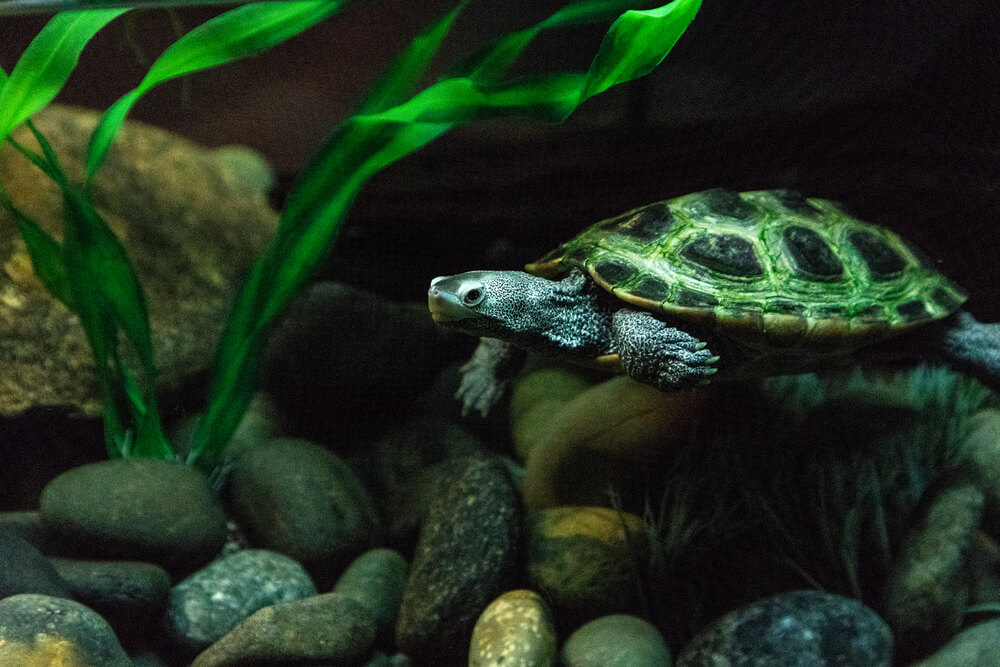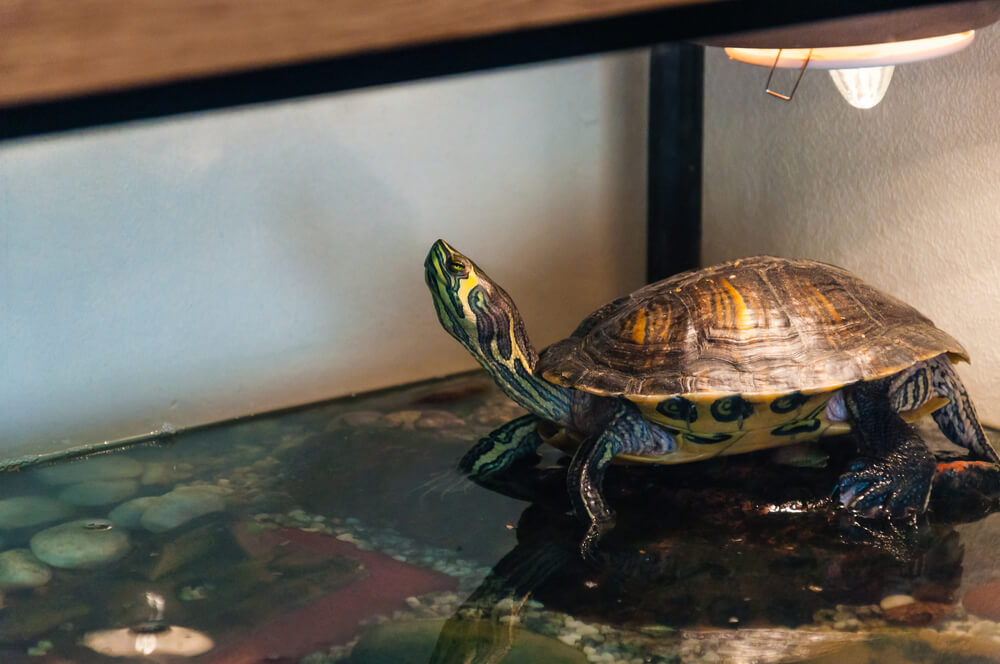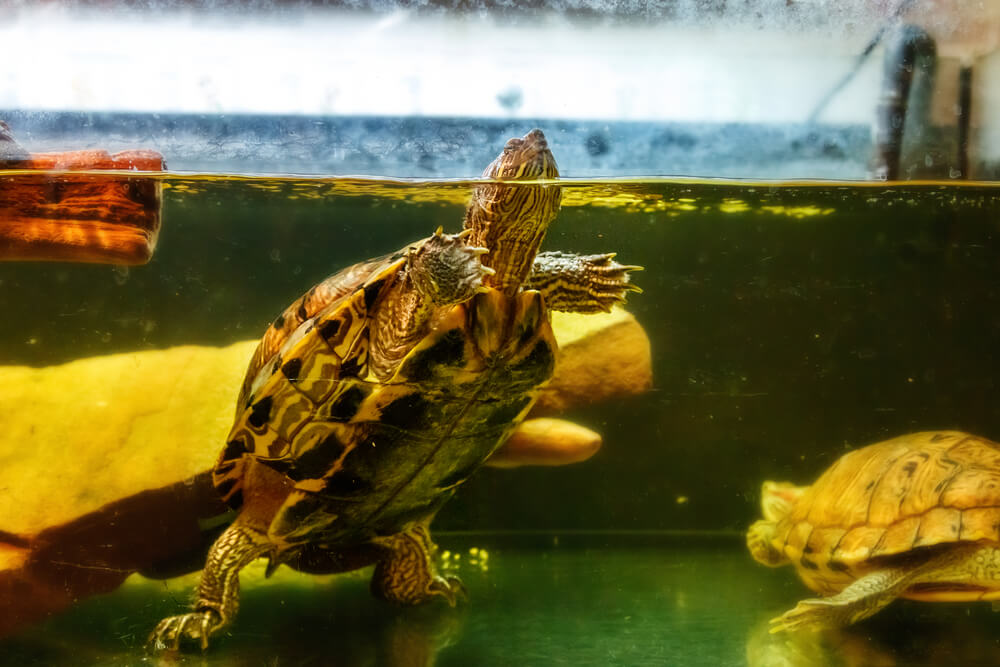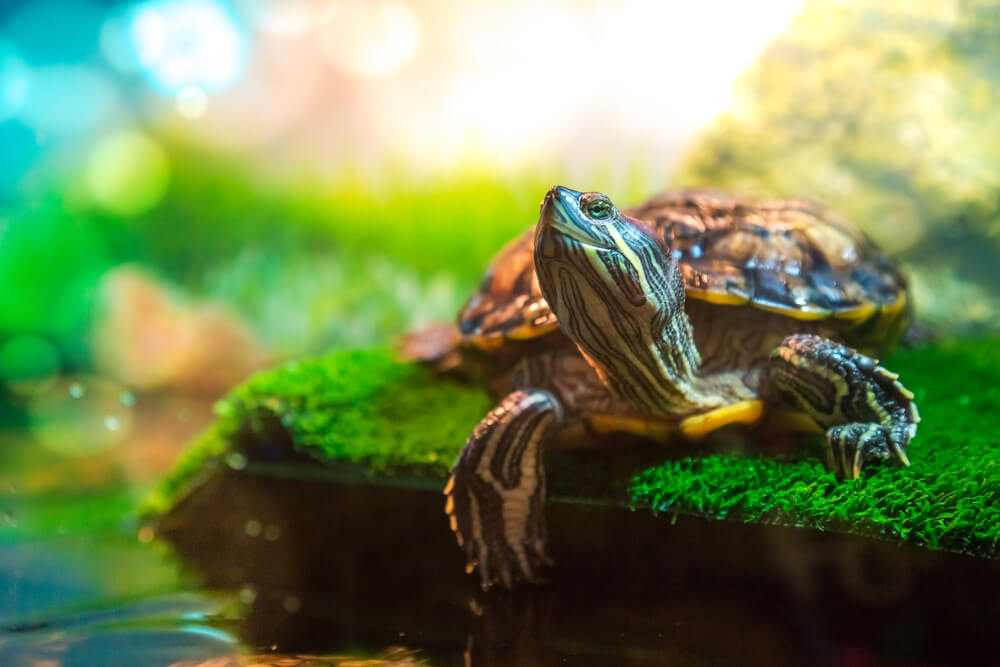As a turtle enthusiast, I know that deciding on the right tank size for our shelled friends is crucial for their health and happiness.
One of the first things that should be considered when bringing a turtle home is how big of a tank does my turtle need. This is because turtles are sensitive creatures that require adequate space, water conditions, and basking areas to thrive.
Turtles come in various shapes and sizes, with different species having their unique habitat requirements. This means that the size of the tank our turtle needs depends on the species and its growth potential.
Although it might be tempting to purchase a smaller tank initially, keep in mind that our turtle will grow and, eventually, require more space to swim, bask, and explore.
Key Takeaways
- Choosing a tank based on the turtle’s species and growth potential is essential
- Ensure that the tank setup meets the basic requirements for water quality, basking areas, and decor
- Be aware of common myths and misconceptions to provide the best care for your turtle
How Big Of A Tank Does My Turtle Need?

Identifying Your Turtle Species
It’s essential to identify my turtle’s species since different species have varying requirements for tank size, water depth, and habitat. I can consult an online identification guide or consult with a specialist to accurately determine my turtle’s exact species.
Life Span And Gradual Growth
A significant factor I must consider when selecting a tank is my turtle’s growth over time. Turtles can live for many years, with some species having a lifespan of over 30 years.
Over time, my turtle will grow, and as it grows, I should make sure its tank remains suitable. I can periodically measure my turtle’s shell and consult its species’ average growth rates to anticipate any necessary tank adjustments.
Turtle’s Natural Habitat
In order to provide the best environment for my turtle, I must consider replicating its natural habitat within the tank. Factors such as water depth, temperature, and substrate need to be considered, as well as any specific vegetation that might be beneficial for my turtle.
Researching my specific turtle species will help me understand its habitat preferences and needs.
Choosing A Suitable Turtle Tank
Glass Vs Acrylic Tanks
When it comes to selecting a turtle tank, the first decision I need to make is between glass and acrylic materials. Both have their pros and cons. Glass tanks are generally more affordable, scratch-resistant, and have better clarity.
On the other hand, acrylic tanks are lighter, more durable, and maintain their clarity longer. Nevertheless, they’re prone to scratching and can be more expensive than glass tanks. In the end, it comes down to my preferences and budget.
Understanding Tank Size
The size of the tank is crucial for the well-being of my pet turtle. A rule of thumb I follow is the “10 gallons per inch of shell” rule. This means that for every inch of my turtle’s shell length, I should provide 10 gallons of tank space.
For example, if my turtle has a 5-inch shell, I would need a 50-gallon tank. This ensures that the turtle has ample room to swim, bask, and explore, promoting a healthy and happy pet.
| Shell Length (in inches) | Tank Size (in gallons) |
|---|---|
| 4 | 40 |
| 6 | 60 |
| 8 | 80 |
| 10 | 100 |
The Importance Of Water Depth
Water depth is another vital factor in choosing a turtle tank. Proper water depth allows my turtle to swim comfortably, which is crucial for maintaining their health.
As a general guideline, I follow the rule that the turtle should be able to swim a distance of two to three times its shell length in any direction. This allows for comfortable swimming, exploration, and basking.
I also make sure to include a basking area within the tank, ensuring that my turtle has space to dry off and warm up under a heat lamp.
Selecting the right turtle tank involves considering the material, size, and water depth. By taking the time to choose a suitable tank, I ensure my pet turtle’s health and happiness.
Importance of Basking Area and Lighting

The basking area is crucial for a turtle’s well-being. I’ve found that providing a proper basking area and lighting in the tank is essential for a turtle’s growth, health, and happiness.
Setting Up Basking Area
Creating a comfortable and accessible basking area for my turtles allows them to warm up and regulate their body temperature. I make sure to choose a spot with a gentle slope, making it easy for them to climb and rest.
Using rocks, driftwood, or commercially available basking platforms, I ensure the basking area is stable and safe.
Proper Lighting Installation
Installing the correct lighting setup is vital to creating the optimal environment for my turtle’s basking. I position the basking lamp directly over the basking area and maintain a safe distance from the platform to prevent overheating.
Further, I make sure there’s a secure barrier, such as a protective screen, to avoid contact between my turtle and the lamp.
UV and Heat Requirements
My turtle needs both UVB and UVA light to maintain proper health. UVB light is essential for the synthesis of vitamin D3, which in turn helps with calcium absorption for healthy bones and shells. UVA light stimulates appetite, breeding, and overall well-being.
To manage a proper temperature gradient in the tank, I use two types of lamps: a UVB light and a heat lamp. I place the UVB light above the basking area, making sure the bulb emits adequate levels of UVB radiation.
I also maintain a consistent temperature in the basking spot using a heat lamp.
In my experience, monitoring and adjusting the lighting and temperature regularly is important to maintain a healthy environment for my turtle.
By providing the ideal basking area and lighting setup, I can ensure my turtle’s growth and happiness.
Maintaining Optimal Water Conditions

Importance of Water Filtration
I cannot stress enough the significance of a good filtration system for my turtle’s tank. A high-quality water filter is crucial in maintaining a clean and healthy environment for my pet.
The filter eliminates waste, debris, and harmful chemicals that could harm my turtle. I’ve found that it’s best to invest in a reliable filter to ensure optimal water conditions in the long run.
Water Changes and Conditioning
Regular water changes are essential for preserving water quality as well. I typically perform water changes every week, with a 25% to 50% water replacement.
In doing it, I ensure the water is clean and free of any potential toxins. Using tap water could introduce harmful elements into my turtle’s environment, so I always use a water conditioner to neutralize chlorine, chloramines, and heavy metals, ensuring maximum safety.
Heated and Filtered Water
Turtles require heated and filtered water to thrive. I make sure the water in my turtle’s tank is properly heated by using a water heater. The ideal temperature depends on the specific turtle species, but in general, it should be between 75°F and 85°F (24°C and 29°C).
It’s essential to monitor the water temperature in the tank and adjust the heater as needed.
Lastly, I make sure the water level is the appropriate height for my turtle species. For example, some turtles are more aquatic than others and require deeper water, while others need a shallower water level.
Having the right water level and maintaining optimal water conditions ensures my turtle will lead a long and healthy life.
Turtle Tank Decor and Substrate
Selecting Safe Decorations
When choosing decorations for my turtle’s tank, it’s essential to prioritize their safety. Turtles love exploring and hiding, so providing plenty of sturdy, non-toxic decorations is crucial.
I opt for natural elements like rocks and driftwood, making sure they have no sharp edges and are adequately cleaned to avoid introducing harmful elements to the tank.
Also, I avoid small, easily breakable, or ingestible decorations that can endanger my turtle’s health.
Choosing Right Substrate
Selecting the right substrate serves as a comfortable flooring for my turtle and also promotes a healthy tank environment.
There are several options available, such as:
- Sand: It is a popular choice as it is comfortable for the turtle, cheap, and easy to clean. However, I make sure to use fine, non-dusty sand and monitor my turtle for any signs of impaction.
- River rocks or gravel: They create a natural, visually appealing environment. I prefer to use larger rocks to prevent ingestion and ensure they are smooth to avoid possible injuries.
- Bare-bottom tank: Some turtle keepers skip the substrate entirely – it facilitates easier cleaning and eliminates any risk associated with substrate ingestion.
Utilizing Aquatic Plants
Incorporating aquatic plants is another excellent way to enhance the aesthetic and functionality of my turtle’s tank. They provide natural cover and oxygen, contributing to a healthier environment.
Some suitable plant options for turtle tanks include:
- Java Fern: A low-light, hardy plant that is easy to grow and maintain.
- Anubias: Another robust low-light plant that can be attached to rocks and driftwood.
- Amazon Sword: A more substantial plant that can offer excellent hiding spots for turtles.
It’s essential to keep in mind that turtles might nibble on plants, so replacing them periodically may be necessary. Choosing fast-growing species can be a wise choice in this case.
Caring For Specific Turtle Species

Red-Eared Slider Care
As I care for my red-eared sliders, I’ve learned that it’s important to give them an adequately sized tank. I’ve found that a 40-gallon tank works well for a juvenile, but as they grow, they require a larger space.
A tank of around 100 gallons is suitable for an adult red-eared slider. In order to maintain their health, I make sure to include both a dry basking area and a water area in their tank.
Providing a proper UVB source and maintaining water temperature between 75 – 85°F (24 – 29°C) is essential for their well-being.
Box Turtle Habitat Setting
When it comes to my box turtle, I know that creating a proper habitat is crucial. One may think that they prefer water, but box turtles are actually considered semi-terrestrial creatures. I aim to mimic their natural environment within an enclosure, allowing them to comfortably roam and burrow.
A mixture of organic soil, coconut coir, or cypress mulch works well for their substrate. I maintain a temperature of about 70 – 85°F (21 – 29°C) with the assistance of a heat lamp. It’s vital to provide hiding spots and a shallow water dish for them as well.
Caring For Western Painted Turtle
In my experience, when it comes to a Western-painted turtle, a minimum of a 40-gallon tank is needed. These turtles are avid swimmers, so offering them a larger water area is appreciated.
As they grow, an increase in tank size may be necessary. For this species, maintaining a water temperature around 68 – 78°F (20 – 26°C) is essential. Like the red-eared slider, the Western painted turtle needs an area for basking with access to proper UVB lighting.
Last but not least, I ensure to offer them a well-rounded diet that includes leafy greens, aquatic plants, and insects.
Addressing Common Myths and Misconceptions
There are quite a few myths and misconceptions surrounding the topic of turtle tanks and their ideal sizes. As a turtle owner, it’s crucial to address these misconceptions in order to provide the best environment for my pet.
Let me debunk some common myths and set the record straight.
Myth: A small turtle needs a small tank.
While it may be tempting to think that a small turtle can thrive in a small tank, this is not necessarily true. Turtles grow throughout their lives, and starting off with a small tank can lead to problems down the line.
An appropriately sized tank for a turtle should allow for ample swimming space and be large enough to accommodate its expected adult size.
Myth: Turtles don’t need a lot of water.
Some mistakenly believe that turtles are content with shallow water, but turtles actually require a considerable amount of water to stay healthy.
Most aquatic species prefer a water depth that is at least twice their shell length – this gives them the space to dive, swim, and properly stretch their legs.
Myth: One gallon of water per inch of shell is sufficient.
While the “one gallon per inch” rule may be a good starting point, it’s not a definitive guide for determining a tank’s ideal size. Turtles are active swimmers and require room to move around.
As a general rule, aim for a tank that has at least five to ten gallons of water per inch of shell length.
To sum it up, it’s important to look beyond popular myths and misconceptions when considering the appropriate tank size for my turtle.
By doing so, I can provide a comfortable and stimulating environment for my pet, ensuring its well-being and happiness.
Considerations For Budget and Maintenance

When it comes to turtle keeping, budget and maintenance are important factors to consider.
In this section, I will discuss the costs associated with turtle ownership and the necessary steps for cleaning and maintaining their tanks.
Price of Keeping a Turtle
Owning a turtle may seem like a low-cost venture, but it can be more expensive than you think. First, you need to consider the price of the turtle itself.
Depending on the breed and age, prices can vary considerably. Beyond that, you need to factor in the cost of setting up their living space. Depending on the size and type of tank required, this can range from $100 to over $500.
Other costs to keep in mind are:
- Heating and Lighting: Turtles require a basking area with a heat lamp and a UV light, which may cost around $50 to $100.
- Filters and Pumps: These are essential for a clean and healthy tank environment. Expect to spend anywhere between $30 to $150 for these items.
- Substrate: The material used at the bottom of the tank, such as gravel or sand, will cost between $10 to $20.
- Decorations and Hideouts: While not strictly necessary, these can enrich your turtle’s environment. Plan to spend $20 to $50 on these items.
- Food: A healthy diet plays a vital role in a turtle’s well-being. Supplementing their diet with fresh produce, dried insects, or pellets can cost around $10 to $30 per month.
Cleaning and Regular Maintenance
Maintaining a clean turtle tank is essential for your pet’s health. A dirty tank can lead to health issues, such as bacterial infections or poor water quality.
Therefore, it’s crucial to establish a consistent cleaning and maintenance routine.
Some tips for tank cleaning include:
- Daily: Remove uneaten food and check the water level to ensure it is suitable for your turtle’s needs.
- Weekly: Inspect the filter for debris and clean or replace cartridges as necessary.
- Monthly: Perform a partial water change of about 25 to 50% of the total tank volume. Use this time to clean the tank’s glass, decorations, and substrate.
- As needed: Periodically, you should deep clean the tank by doing a 100% water change, scrubbing the tank elements, and cleaning the filter system with a mild detergent solution. Be sure to rinse thoroughly to remove any traces of cleaning chemicals.
Keep in mind that a larger tank will cycle better and stay cleaner for more extended periods. Yet, it may require more time and effort to maintain, so it’s essential to find the right balance between your turtle’s needs and your maintenance capabilities.
Frequently Asked Questions
What size aquarium is best for my turtle?
I recommend choosing an aquarium that is at least four to five times the length of your turtle. This allows space for swimming, basking, and hiding. Keep in mind the growth potential of the turtle when selecting a tank.
How many gallons per inch of turtle do I need?
It’s suggested to provide at least 10 gallons of water per inch of turtle shell length. For example, if your turtle measures 4 inches, a 40-gallon tank would be suitable.
What is the minimum tank size for a single turtle?
The minimum tank size for a single turtle is largely determined by the species and adult size of the turtle. As a general rule, consider a 40-gallon aquarium as the minimum size for a single turtle.
How does the number of turtles affect the tank size?
As the number of turtles increases, so does the size of the tank needed. Adding another turtle will require increasing the tank size by 1.5 times the original volume per additional turtle. This ensures ample swimming and basking space for each turtle.
Can I use a smaller tank for a temporary setup?
A smaller tank can be used temporarily, especially for young turtles. However, it’s important to monitor the turtle’s growth and upgrade to an appropriately sized enclosure as the turtle grows. It’s not ideal to keep a turtle in a small tank for the long term.
What factors determine the right turtle tank size?
Several factors determine the right tank size for your turtle: species, adult size, number of turtles, and their age. Taking these factors into consideration, along with providing enough space for swimming, basking, and hiding, will help you choose the right tank size.














